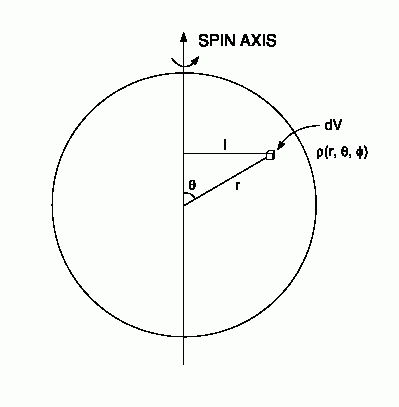EARTH’S MASS, DENSITY, AND MOMENT OF INERTIA
To learn what the earth is made of, our first constraint is its density (mass / volume).
We find its mass from the acceleration of gravity g
The universal law of gravity says that the force F betwen objects M and m
a distance r apart is given by the inverse square law
F = GMm / r 2
From experiments, the gravitational constant
G = 6.67 x 10 -8 dyne-cm 2 / gm 2 = 6.67 x 10 -11 N-m 2 / kg 2
So, consider a small object at the earth’s surface (radius R)
Using Newton’s second law that force F = m a = mass times acceleration
The acceleration of gravity at the surface, g , is
g = F / M = G M / R 2
Note that since m drops out, all objects fall at same speed
We measure g = 980 cm/sec 2 = 9.8 m/ sec 2 , so
M = ( 6371 x 10 3 ) 2 9.8 / 6.67 x 10 -11 = 5.95 x 10 24 kg
ANOTHER METHOD OF FINDING MASS
To check the result, we can use rotation period of satellite about earth. If we assume an object in circular orbit with radius r, the centripetal acceleration that accelerates inward and keeps the satellite in orbit is V 2 / r
The force causing this is gravity, so from F = m a
F = G M / r 2 = V 2 / r and the mass M = r V 2 / G
To use this we need the speed V of the satellite, which we find from the period that the satellite takes to make one orbit, T = 2 P r / V
M = r (2 P r / T ) 2/ G = r 3 (2 P / T ) 2/ G
This method could be used even before artificial sdatellites Consider the moon – it’s really in elliptical orbit but assume it’s circular.
First, we need the radius of the orbit of moon about the earth. This has been
known since Ptolemy (140 AD) used his knowledge of earth’s radius
We can measure the angle fromvertical q to the moon, at a site an angular distance f from another site at where the moon is overhead (or at same place at two different times). Given the earth’s radius R, we have two angles of a triangle and one side, so the distance can be found. Ptolemy estimated the distance to the moon as 59 times earth’s radius- 59 x 6371 = 375,889 km. This was a good estimate, because the modern value = 384,405 km.
Hence the radius of the orbit r = 3.84 x 10 5 km = 3.84 x 10 7 m
and the period T = 27.3 days = 2.36 x 10 6 sec give the mass
M = 6.1 x 10 24 kg , which agrees with our earlier result.
Note that this analysis involves being careful with the units!
Now, the earth’s average (mean) density can be found
r = M / V = M / [ (4/ 3) p R 3 ] = 5.5 gm/cm 3
Surface rocks have density 2.8 to 3 5 gm/cm 3. So the interior is on the average denser – due (as we will see, to a dense core). It’s probably not hollow (whatever movies show).
This analysis only get us so far-since we don’t know if all the mass is near the surface or at depth-any distribution with the same total mass will work.
MOMENT OF INERTIA
Another constraint comes from the earth’s moment of inertia.
Remember from freshman physics that just as for linear motion
momentum = (mass) (velocity)
rotating bodies have
angular momentum = (moment of inertia) (angular velocity)
L = I w
Just as the linear velocity gives the change in position per unit time, the angular velocity or rotation rate is the change in angle per unit time
w = d q / d t
Similarly, just as mass measures an object’s resistance to acceleration, its moment of inertia I shows how hard it is to get it rotating. To find I we
consider a body to be made up of volumes dVi with masses mi
and sum (or integrate) them weighted by their perpendicular distance
li from the rotation axis
I = S m i ( l i ) 2 = ò r l 2 dv
We won’t prove it (we do in 324), but the ratio I / ( M R 2 ), where
R is the planet’s radius and M is its mass depends on the density of
distribution.
If the planet is homogenous (uniform density) , I / ( M R 2 ) = 0.4
If all the mass is on the outside, I / ( M R 2 ) = 0.667
The moment of interia is higher, for the same mass, because material is further from the rotation axis.
For a two layer planet with a mantle of density 5 gm/cm3 and a denser core, with density 10 gm/cm3 whose radius is 0.55 that of the entire planet,
I / ( M R 2 ) = 0.36
The smaller I / ( M R 2 ) , the more the mass is concentrated in the center.
For the Earth I / ( M R 2 =0. 33 due to the dense core.
For the Moon I / ( M R 2 ) = 0. 395, so it’s close to homogenous
For Saturn I / ( M R 2 ) = 0.22 -much denser at center
For the Sun I / ( M R 2 ) = 0.06, so it is very much denser at center.
We’ll see why these occur, later…



